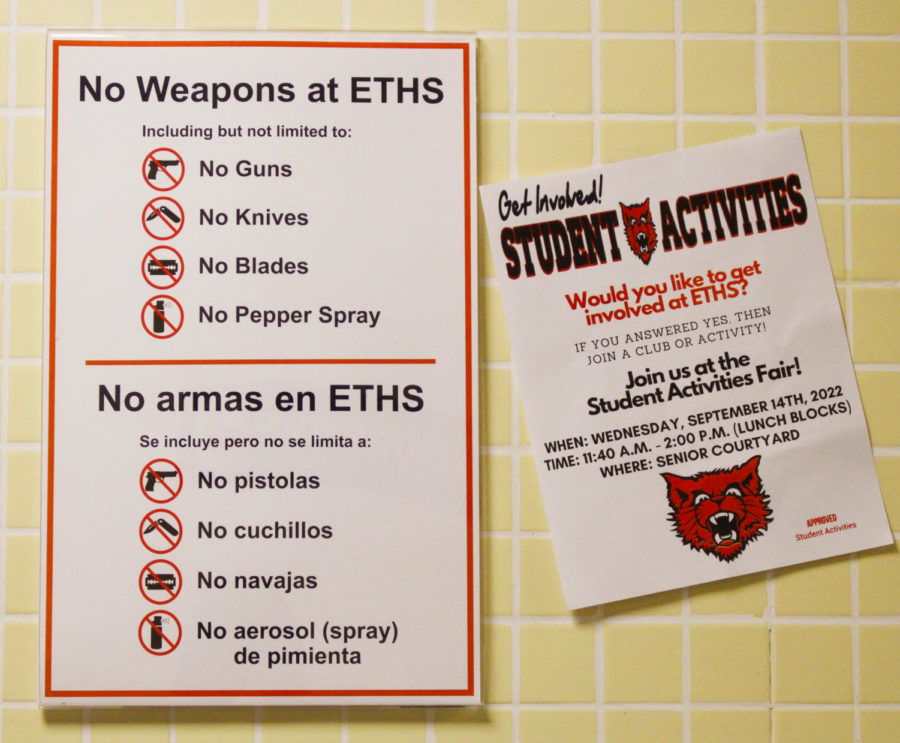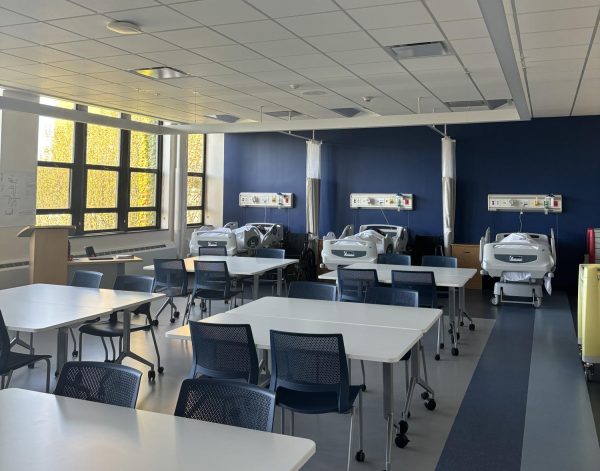New safety enhancements to kick off new school year
On Dec. 16, 2021, when ETHS underwent a lockdown due to students illegally possessing guns on school property, many members of the Evanston community expressed concerns over the safety of students at ETHS.
Amid a rise in mass shootings in the U.S. in recent years, the topic of safety at school has only become more prevalent. In response, ETHS reached out to the Facility Engineering Association (FEA) to conduct a series of interviews and evaluations regarding safety at the high school. The results of the analysis have led to changes to the school’s safety policy that were instituted at the start of this school year.
At the start of this academic year, ETHS administration sent out an email detailing each individual change that has come as a result of the FEA assessment. These changes include structural improvements to key locations in the building, like doors and fences, but also changes to safety practices implemented during a regular school day.
One of the most notable changes to the everyday operation of the school is the emphasis placed on using identification cards to identify one another and to get in and out of locations during the school day. Staff members are now required to wear their ID constantly throughout their time spent in the building, and if students are going to spaces that aren’t their classrooms, (like cafeterias, study centers, and doors to exit the building), they are required to scan their IDs. While some of these identification practices aren’t new this year, they are all part of a renewed effort to monitor activity within the school building.
“Making sure that we’ve got our consistency of practices is really important,” said Taya Kinzie, Assistant Superintendent and Principal at ETHS. “So we are scanning in and scanning out, and we’re doing that very consistently. It’s not just, ‘Oh, it’s lunchtime.’ We wanted to look at what our systems are and how consistently we are implementing them, so that we’re ensuring that’s all in place.”
Another important safety practice that is being emphasized this year is the presence of safety officers around the building. When walking around the building, one can see the distinctive orange shirts of the unarmed safety officers while they are monitoring hallways, bathrooms and important entry and exit points. But even though safety officers are there to try to stop wrongdoing at ETHS, the goal isn’t to take away all the humanity of the school experience.
“They know all the staff, all the students’ faces; I’m just always impressed,” said Kinzie. “That’s an important piece of it that we focus on a lot, the humanizing element of [safety at ETHS].”
All these new policies contribute to the goal of improving the monitoring of ETHS facilities.
“Students are going to be in designated spaces, and they’re going to be in designated spaces after school, [it’s] not just anybody kind of in and out so that we’re all being accountable to each other and supportive of each other,” said Kinzie. “Those are some of those technical pieces that we’re really paying attention to. [We ask ourselves] who’s in the building? How are we supporting each other? How are we making sure we’re in our designated spaces? And what does that look like?”
In addition to monitoring improvements, ETHS has also updated its staff training program. Kinzie highlighted the importance of training all the leaders of ETHS in how to react in a potentially dangerous situation, not just the designated safety staff.
“If Mr. Driscoll, (the director of safety), isn’t here, any one of us needs to be ready to jump in and prepare to support every single person here, because we’re responsible for you all. And we take that very, very seriously.”
Many of the new safety enhancements implemented at ETHS this year stem directly from the FEA audit conducted last spring. The FEA is a corporation that analyzes facilities and determines how to improve them, and their role during the audit last year was to figure out what was working at ETHS (in terms of safety) and what needed to be improved. ETHS has completed some internal audits about their safety measures in past years, but the FEA one has had some considerable impact on the new policies this year.
“Most of what we put into place were things that were on our radar for implementation anyway, but some of which were recommendations from the FEA about scanning [and other safety practices],” Kinzie said “We are taking into consideration those recommendations as we look at moving forward. [The FEA assessment] was a really comprehensive audit of our entire facilities, inside and outside.”
Student opinion on the safety changes has been somewhat controversial. While many understand the FEA assessment’s need and the changes it brings, there is concern over everyday learning being disrupted by drills, limited access to workspaces and more.
“It’s really frustrating; we’ve been limited with entrances. I don’t know why they closed entrance 3; they keep talking about phones, the signs. Not bringing weapons into school is already an assumption, anyone who wants to do that isn’t being stopped by a sign in front of the sink,” said senior Delcene Ralaingita.
“I get that this stuff is necessary, and maybe it’ll end up helping in the long run. But right now, I don’t know how much of a difference it’s making. Sometimes it feels like the school doesn’t care. Like they care more about the image they show to the public instead of trying to make us really feel safer. I want it to help, I hope it’ll help.”
In a similar way to how students have to follow the new safety rules, teachers at ETHS have a very important job when implementing them. It is up to them whether or not students can go to the bathroom, take a brain break or sit outside the classroom to work on assignments. However, teachers’ ability to grant some of these privileges to the extent that they wish to has been limited.
“I have been told that I’m not allowed to put students out in the hallway. And that’s a pain for me because sometimes you’ve got to switch it up. I’ve seen teachers do it anyway,” said Julian Sotnick, a history teacher at ETHS entering his 26th year.
He also called into question the impact of the new rule changes.
“Students have to be safe and have to feel safe. That’s critically important. But I’m not sure any of these recommendations are going to make that happen. Am I doing anything differently day-to-day, this year than I was last year? Not so much. And we don’t want to make things too difficult for teachers to be able to implement their lesson plans. So it’s about striking the right balance,” said Sotnick. “But I’ve never felt that the school was never a safe place physically.”
There will be more improvements coming to safety policy this year, as Kinzie believes that there is always more work to be done in the effort to create a safe learning environment. It is clear that the ETHS administration’s priority is to improve the safety of its students. However, teachers and students alike wonder whether the changes will make enough of a difference.
“There’s lots more to come, because this is what we see as an ongoing process. We did before and we’re going to continue to,” said Kinzie. “We’re going to be having a lot of conversations about [safety at ETHS] this fall.”
Your donation will support the student journalists of the Evanstonian. We are planning a big trip to the Journalism Educators Association conference in Philadelphia in November 2023, and any support will go towards making that trip a reality. Contributions will appear as a charge from SNOSite. Donations are NOT tax-deductible.














